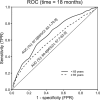Differences in association between hypoalbuminaemia and mortality among younger versus older patients on haemodialysis
- PMID: 39781478
- PMCID: PMC11707383
- DOI: 10.1093/ckj/sfae339
Differences in association between hypoalbuminaemia and mortality among younger versus older patients on haemodialysis
Abstract
Background: Ageing often affects biomarker production. Yet, clinical/optimal thresholds to guide clinical decisions do not consider this. Serum albumin decreases with age, but hypoalbuminaemia is defined as serum albumin <4.0 g/dl. This study explores whether age might affect serum albumin levels and its association with mortality in haemodialysis patients.
Methods: COSMOS (Current Management of Secondary Hyperparathyroidism: a Multicentre Observational Study) is a prospective, open-cohort, observational study of haemodialysis patients followed for 3 years. Binary logistic and linear regression were used to analyse the association between age and hypoalbuminaemia or serum albumin (continuous). Cox proportional hazard multivariate regression was used to examine the relationship between hypoalbuminaemia and mortality in patients younger and older than 65 years. Time-dependent receiver operating characteristic (ROC) curves were used to assess the discriminatory ability of serum albumin and optimal thresholds for predicting mortality.
Results: The present analysis included 5585 patients. The odds of experiencing hypoalbuminaemia increased with age [adjusted odds ratios = 1.56(95%CI: 1.31-1.86), 1.89(95%CI: 1.59-2.24), 2.68(95%CI: 2.22-3.23) for 56-65, 66-75, and >75 years, respectively (reference ≤55 years; P value for trend: <0.001)]. Survival analysis showed that the association between hypoalbuminaemia and mortality was weaker in patients aged ≥65 compared to <65 years [hazard ratios: 1.36(95%CI: 1.17-1.57) and 1.81(95%CI:1.42-2.31) respectively; P value for interaction 0.004]. The ability of albumin levels to predict mortality was consistently higher in younger patients. Optimal albumin thresholds for predicting mortality were 3.7 g/dl in patients younger than 65 years and 3.5 g/dl in patients 65 years and older.
Conclusions: Ageing is accompanied by lower albumin levels, and the association between hypoalbuminaemia and mortality may be modified by age. Different clinical thresholds that consider age may better discriminate risks associated with hypoalbuminaemia.
Keywords: ageing; albumin; chronic kidney disease; haemodialysis; mortality.
© The Author(s) 2024. Published by Oxford University Press on behalf of the ERA.
Conflict of interest statement
J.L.G.-T. declares funding to conduct clinical trials from AstraZeneca, Bayer, Boehringer-Ingelheim, and Novo Nordisk (all to the INCLIVA Research Institute); consulting fees from AstraZeneca, Bayer, Boehringer-Ingelheim, and Novo Nordisk; payment of honoraria for lectures from AstraZeneca, Novo Nordisk, Bayer, Menarini, Boehringer-Ingelheim, and Eli Lilly. J.F. declares speaker and/or consultancy honoraria from AstraZeneca, Bayer, Boehringer, CSL Vifor, HiBio, Novartis, Roche, Omeros, Stada, Travere, Vera Therapeutics; he serves on data safety monitoring boards of NovoNordisk and Q32 Bio; he coordinates the glomerular disease KDIGO guideline. J.B.C.-A. declares speaker and/or consultancy honoraria from SPA Pharma, FAES. He serves as Chairman of data safety monitoring board of Mabxience. The authors are not aware of any additional relationships, funding, or financial holdings that might be perceived as affecting the objectivity of this study.
Figures





References
-
- Clinical practice guidelines for nutrition in chronic renal failure. K/DOQI, National Kidney Foundation. Am J Kidney Dis 2000;35:S17–S104. - PubMed
LinkOut - more resources
Full Text Sources

